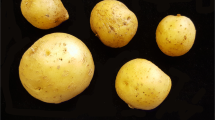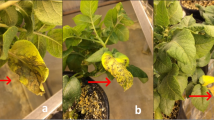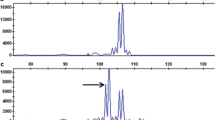Abstract
Tests were made on lines ofSolanum tuberosum spp.andigena to determine 1) whether resistance to potato virus Y exists in the Andigena germplasm, 2) the nature of its inheritance, and 3) the type of resistance.
Results of the isolation and identification studies indicated that the pathogen involved was a common strain of potato virus Y.
Under field conditions susceptible plants frequently escaped infection. However, field exposures over two seasons resulted in the same ratios as tests in which the same progenies were mechanically inoculated.
Mechanical inoculation at the seedling stage proved to be a reliable means of transmission and resulted in accurate screening for resistance. Of 641 tub × tub clones tested, all were susceptible to the virus. Of 366 tub × adg clones tested, 170 were resistant and 196 were susceptible. This fits a 13:15 ratio, assuming random chromatid segregation and a single dominant gene conferring resistance.
Plants that were resistant following mechanical transmission were also resistant when inoculated by aphids, indicating the reliability of mechanical transmission as a means of screening for resistance.
To determine the type of resistance, top-graft and approach-graft tests were made. Failure to recover the virus from resistant plants inoculated by either grafting method suggests that immunity is the type of resistance involved.
Resúmen
Los ensayos se hicieron usando líneas deSolanum tuberosum spp.andigena para determinar: 1) Si existe resistencia a virus Y en el germoplasma andigeno. 2) La naturaleza de su herencia y: 3) Tipo de resistencia. Resultados del aislamiento y los estudios de identificación indican que el patöeno involucrado fue un “strain” común del virus Y. Las plantas susceptibles frecuentemente escapan a la infección en condiciones de campo. Sin embargo, los resultados de exposición en el campo durante dos estaciones fueron iguales en proporción a los experimentos en los cuales las mismas progenies fueron mecánicamente inoculadas La inoculatión mecánica en el estado de plántula demostró de signification para transmitir el virus y resultó ser un método preciso para búsqueda de resistencia. Se probaron 641 clones de tub. × tub. y todos fueron susceptibles al virus. Se probaron 366 clones de tub. × adg. y resultaron 170 clones resistentes y 196 susceptibles. Esto encuadra en una proporción de 13:15, asumiendo segregación cromatida randomizada confiriendo resistencia un simple gen dominante. Las plantas que fueron resistentes a la transmisión por inoculación mecánica, también fueron resistentes cuando se inocularon con áfidos, indicando esto la seguridad de la transmisión mecánica como medio de búsqueda para resistencia. Se hicieron injertos apicales y de aproximación para determinar el tipo de resistencia. No se recuperó el virus de las plantas mencionados, sugiriendo estos resultados que el tipo de resistencia es inmunidad.
Similar content being viewed by others
Literature Cited
Cockerham, G. 1943. Potato breeding for virus resistance. Ann. Appl. Biol. 30:105–108.
Cockerham, G. 1952. Breeding for resistance to potato viruses.In Proc. 1st Conf. Potato Virus Diseases, pp. 37–39. Lisse, Wageningen.
Cockerham, G. 1970. Genetical studies on resistance to potato viruses X and Y. Heredity 25:309–348.
Easton, G. D., Larson, R. H. and Hougas, R. W. 1958. Immunity to virus Y in the genusSolanum. Univ. of Wis. Res. Bull. 205, 32p.
Hutton E. M. 1945. The relationship between necrosis and resistance to virus Y in the potato. 2. Some genetical aspects. J. Counc. Sci. Ind. Res. 18:219–224.
Hutton, E. M. and Bald, J. C. 1945. The relationship between necrosis and resistance to virus Y in the potato. 1. Greenhouse results. J. Coun. Sci. Ind. Res. 18:48–52.
Ross, H. 1952. Studies on mosaic resistance in the potato. In Proc. of the Conf. on potato virus diseases, pp. 40–47. Lisse, Wageningen.
Ross, H. 1958. Inheritance of extreme resistance to virus Y inSolatium stoloniferum and its hybrids withsolarium tuberosum. In Proc. of the 3rd. Conf. on potato virus diseases, pp. 204–211. Lisse, Wageningen.
Webb, R. E. and Schultz, E. S. 1961. Resistanceof Solanum species to potato viruses A, X and Y. Am. Potato J. 38:137–142.
Webb, R. E. and Wilson, D. R. 1973.Solanum demissum PI 230579, a true local lesion host for potato virus Y. Abstracts of the 57th Annual Meeting of the Potato Association of America. Am. Potato J. 50:380–387.
Author information
Authors and Affiliations
Additional information
Paper No. 656 Department of Plant Breeding & Biometry, Cornell Univ., Ithaca, N.Y. This research was supported in part by CIP, Lima, Peru.
Rights and permissions
About this article
Cite this article
Munoz, F.J., Plaisted, R.L. & Thurston, H.D. Resistance to potato virus Y inSolanum tuberosum spp.andigena . American Potato Journal 52, 107–115 (1975). https://doi.org/10.1007/BF02852043
Received:
Issue Date:
DOI: https://doi.org/10.1007/BF02852043




